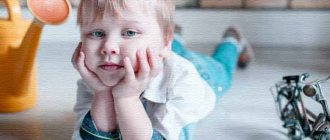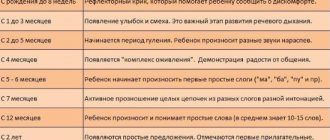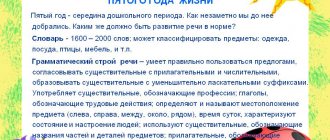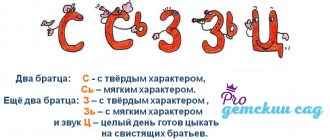Article:
Parents often come to a speech therapist with the question: “Why doesn’t my child pronounce letters and what to do about it?”
I would like to immediately clarify that it is not letters that the child pronounces or does not pronounce, but sounds. Many adults make the mistake of confusing these concepts.
Even in utero, the baby is faced with the sounds that surround his mother. After birth, with each month, the perception of sounds becomes clearer and gradually the baby learns to speak on its own. And only when a child learns to read and write does he become familiar with letters. Letters are special characters that are used to represent sounds in writing. Thus, we hear and pronounce sounds, and we write and read letters.
But let’s return to the parents’ question: “Why doesn’t my child pronounce some letters?” Let's figure out what exactly is a specific feature of speech development of a particular age. After all, in order to see whether a child has problems with speech, it is necessary to compare the development of normal speech with how your child’s speech activity is progressing at the moment.
Age norms for children's speech development
So, the norms for speech development are as follows:
| Stage of speech development | Child's age | Characteristic |
| Scream | From birth | With the help of a cry, a child communicates with the people around him. Attentive mothers very quickly begin to distinguish between a cry of pain, a cry of hunger, a cry of pleasure, etc. By the end of the first month, the baby is already able not only to scream, but also to focus on the conversations of adults and listens to them. |
| Revitalization complex | 3 months | When the mother appears, the baby begins to smile, wave his arms, wiggle his legs and make sounds. If the “revival complex” does not appear until the tenth week, this is an alarming sign that may indicate a delay in mental development. In this case, you should immediately consult a doctor. |
| Booming | 4 months | The baby reproduces various sounds (the rear lingual consonants “g”, “k”, “x” and familiar vowels are used) and their combinations in any order: “gy”, “kh”, “agu”, etc. Gradually it becomes “singing”, new sounds appear, for example “b”, “p”. |
| Babbling | 6 months | Repeated repetition of syllables: “ta-ta-ta,” “dya-dya-dya,” “ma-ma-ma.” At six to nine months, the baby begins to accumulate a passive vocabulary. If you ask: “Where is mom? Where is the ball (or bunny)? then the child begins to look for these objects with his eyes and turn his head in their direction. Also at this age the baby reacts to his name. Good at distinguishing his own people from strangers. The child actively uses gestures in communication, for example, nodding or shaking his head, waving his hand goodbye. |
| Babbling words | 9-12 months | As babbling continues, a transition to words occurs. So-called babbling words appear (mother, woman, am, give). And even if your baby constantly calls the teddy bear “mi-mi,” consider it a word. |
| “Adult words” | 1.7-1.9 months | Usually, children hear adults speak and repeat the words after them as best they can, while simplifying them (pais-sleep, pissy-let's go, moko-milk). This is acceptable for this age. |
| Offers | 2 years | By the age of two, a child learns to use two-word phrases (lala bah, mama am). From the age of two, proposals appear and develop. 2/3 of what a child says is understandable to others. The concepts of “I” and “mine” begin to appear. |
| Grammatically correct speech | 3-4 years | By the age of three, complex sentences appear, almost all parts of speech, conjunctions, prepositions, singular and plural are used. They know their gender, name, age, parents' names. By the age of four, a child’s speech is grammatically correct, suffixes are used in words, and phrases become more complex. |
Experts evaluate the subsequent development of speech based on the ability to answer given questions, the ability to build sequential chains and compose stories from pictures, talk about an event, retell a story or fairy tale, and the presence of initiative in a conversation.
These standards, like any others, are an average indicator on which specialists (speech therapists, speech pathologists, neurologists) rely when making a diagnosis. You need to strive for them and you need to focus on them. But this does not mean at all that all indicators should be exactly like this. Your baby is individual. It develops at its own pace. The main task of parents is to help their baby move in the right direction, and if necessary, provide him with the necessary help in a timely manner.
A child’s speech is like clay: raw clay is easy to give the desired, correct shape. But is it possible to mold something from already dried clay? The result will certainly be disastrous!
Dear mothers and fathers, remember: it is much more difficult to correct “old” speech defects!!!
The first signs of autism
Wednesday, April 12, 2017
Typically, parents begin to worry about their child's development when he or she approaches two years of age. Before this, any lags and deviations can be explained by the individual characteristics of the baby, and one can hope that they will gradually smooth out. By the age of two, an ordinary child, as a rule, masters the simplest skills, but even when this does not happen, he still understands what adults want from him. It’s the same with language: even if he doesn’t speak yet, he understands speech addressed to him quite well, as can be judged by his reactions.
Let's try to list the oddities in the development and behavior of a child that cause concern among parents:
- the child does not make eye contact;
- speaks about himself in the third (he) or second (you) person;
- repeats words and phrases all the time;
- the child began to speak the first words, but speech disappeared;
- does not utter words, hums;
- not interested in toys;
- not interested in peers, does not play with other children;
- the child is distant, ignores the mother, does not respond to requests, does not respond to his name;
- shakes his head, hands, sways;
- walks on tiptoes;
- chews fingers, hands;
- hits himself in the face;
- the child has hysterics, attacks of aggression;
- afraid of strangers/strangers;
- gets scared by sounds, shudders.
If any of these traits are present in your child, it is not necessarily autism. However, it's worth worrying about. Take the M-CHAT Autism Screening Test. You can also watch videos of signs of autism in the behavior of children - Video - Signs of Autism.
There is a short diagnostic test consisting of three questions:
- Does your child look in the same direction as you when you try to get his attention to something interesting?
- Does your child point at something to get your attention, not to get what you want, but to share your interest in the subject?
- Does he play with toys, imitating the actions of adults? (Pours tea into a toy cup, puts the doll to sleep, not just rolls the car back and forth, but carries the blocks in a truck to the construction site).
If the answer to all three questions is negative, the parents of a 2-3 year old child have reason to show him to a specialist. If, on the contrary, it is positive, then most likely the delay in speech development and the acquisition of skills has another reason, not autism.
Behavior of a little autist
Autism is, first of all, a violation of the communicative function, the child’s contact with the people around him. The child lives in a world of visual images, sounds, tactile sensations, but at the same time, impressions are valuable in themselves; he does not seek to share them with mom or dad, who perform an exclusively instrumental function for him, being sources of food, warmth, and comfort. Such children are characterized by repetitive, obsessive actions: some spend hours spinning all the spinning objects that come to hand, from a small ball to the lid of a large pan, watching water pouring from the tap, some lining up cars or cubes in a row, some playing with a thread, twisting it around your finger or shaking it before your eyes. They can spin in one place for a long time or walk around the room on tiptoe in circles.
Often little autistic people are extremely musical: they get obvious pleasure from their favorite pieces of music, melodies and even individual sounds. A three-year-old child can walk completely indifferently past a peer with a remote-controlled car, but be indescribably delighted at the sound of the clock striking a cathedral.
The little autistic child looks confident and independent. While walking, he walks alone, resists attempts to take his hand, and only when frightened by something, for example, a large dog, does he hide behind an adult. But his fears are not always explainable from the point of view of ordinary logic: he is afraid of a vacuum cleaner, he is frightened by noisy, crowded places, but, as a rule, he is not aware of the danger associated with heights or traffic, he can jump out onto the roadway and even lie down across.
As a rule, he stops his mother’s attempts to calm him down, caress him, hug him, pushing her away from him. What can we say about physical contacts with strangers, a doctor or a hairdresser, for example. A medical examination or haircut becomes stressful for everyone involved due to intense resistance. Feeding is also a problem. The child is so selective in food that sometimes his diet consists of only three or four dishes (for example, cottage cheese, porridge, banana), everything else is unconditionally rejected.
It is very difficult to persuade a little autistic person to interrupt an activity if he is passionate about something, to convince him to try something new, and parental volitional actions (taking him off the swing, taking him home from a walk, feeding him, putting him on the potty) cause violent hysteria, and sometimes aggression. .
Neurotypical (i.e., those without developmental disabilities) children enjoy imitating the actions of adults. The girl takes a comb and runs it over her head; looking at mom, after eating she wipes her mouth with a napkin, picks up the phone and says something. A three-year-old boy hangs around his first-grader brother, who is doing his homework, and if you give him a pencil and paper, he will happily start scribbling. Following his mother, a one-year-old child strokes a teddy bear that has fallen from the sofa, feeling sorry for it at first only formally, but gradually becoming imbued with the emotional content of the action. Imitation is an evolutionary mechanism underlying the learning of social skills and social support. By imitating, the child gives us a signal of readiness to master skills and formal actions, which are gradually filled with socially significant content.
Autistic children and their parents find themselves in a vicious circle: the child sometimes does not imitate even the simplest, most ordinary actions, the mother does not receive a readiness signal, and the skill does not develop. When parents come to their senses and urgently begin to teach the child what his peers have long mastered (eating with a spoon, using the potty, putting on socks), their volitional actions, as a rule, cause active rejection in the child: firstly, he lacks a motive (standard the reward/punishment system does not work with such a child); secondly, he wants to return as soon as possible to an activity that brings him deep satisfaction - for example, opening and closing desk or cabinet drawers, slamming doors, looking at pictures in a favorite book for the hundredth time.
Speech and communication
Speech in autistic people, as a rule, appears later than usual, but the point is not so much in the timing as in its specificity. The first word of an autistic child, as a rule, is not “mom,” “dad,” or “give” (the traditional triad of a neurotypical child), but, for example, “lawnmower,” that is, the name of an object that, for some reason, produced a special impression, and most often this is an inanimate object (in parentheses, we note that autistics learn to distinguish between living and inanimate things later than neurotypicals). When a little autistic person moves from individual words to sentences, they are also more of a naming nature. The child likes to repeat names, pieces of text from poetry or advertising, often he does not understand the meaning of the spoken sentences. Knowing the right words, he cannot make a request and does not always understand the requests addressed to him. When meeting a new person, he examines his appearance for a long time and at this time does not at all perceive the words addressed to him.
The little autistic child does not know how to communicate in dialogue. Does not ask questions himself, cannot answer a question, repeating it after the interlocutor. "What is your name?" - "What is your name?" - “Don’t repeat it, answer it!” - “Don’t repeat it, answer it!” and so on. This phenomenon is called echolalia. The child does not use the pronoun “I” when talking about himself “you don’t want to take the tram” or “he will watch a cartoon.” Speech, as a rule, develops, and echolalia can go away by 4–5, sometimes by 7–8 years, but it can linger seriously and for a long time.
If you are concerned about something about your child's behavior:
— Take the M-CHAT autism risk screening test;
- Contact your local pediatrician or neurologist;
- Contact a psychologist or psychiatrist.
Why doesn't the child pronounce some sounds? Why do speech disorders occur?
Of course, the true cause must be determined by a doctor. Most likely, it will be necessary to consult not only a speech therapist, but also other specialists, such as a neurologist, psychiatrist, or otolaryngologist. But you yourself are able to guess what could affect the delay in speech.
Possible reasons:
- Negative factors during pregnancy and childbirth.
- Frequent illnesses, infections and injuries for up to three years. This is the period when speech is intensively formed.
- Decreased physiological hearing.
- Underdevelopment of phonemic hearing (the ability to isolate, reproduce, distinguish speech sounds).
- Imitation of incorrect speech. Often adults adapt to the child’s speech and “babble” with children for a long time. Such speech does not stimulate correct sound pronunciation and perpetuates its shortcomings. The same thing happens when a child constantly communicates with younger children. It happens that someone in the family does not pronounce certain sounds and the child copies this incorrect sound pronunciation. If a child often communicates with people with unclear, hasty speech, this causes particular harm.
- Bilingualism in the family.
- Pedagogical neglect. Usually, with pedagogical neglect, the normal development of speech is inhibited due to the fact that parents do not pay attention to their child’s speech, do not notice violations, do not correct mistakes, do not give correct pronunciation samples, and do not develop speech.
- Disadvantages of the speech apparatus: malocclusion, short frenulum of the tongue, narrow, very high or flat palate.
Sound pronunciation disorders manifest themselves in speech in different ways:
- This or that sound is missing: rocket (aketa), moon (una).
- Sound distortion: for example, instead of the standard r, a velar or uvelar sound (burr) is pronounced, or instead of the standard s, z, w, zh, c, interdental sounds are pronounced when the tip of the tongue falls out between the teeth
- Replacing one sound with another, available in the phonetic system of the Russian language: shishka-syska, mouth-lot, etc.
There are many diagnoses for speech disorders, such as dyslalia, dysarthria, stuttering, rhinolalia, alalia, mutism, autism, and general speech underdevelopment.
Of course, you don’t need to try to put them on your child yourself. For this purpose, it is better to visit a specialist.
All these violations are quite serious, which most often cannot be corrected in the year before school. If they are not eliminated by the age of 6, then they will most likely turn into persistent and complex ones and will come back to haunt the school with reading and writing disorders.
Therefore, do not close your eyes to any deviations in the speech of your children! Almost every violation can be corrected, the main thing is not to waste time. I would like to note that it is important to correct speech impairments in a comprehensive manner, with the participation of a speech therapist, neurologist, pediatrician, psychiatrist, speech pathologist, and psychologist. You may need the services of an audiologist, endocrinologist, or ophthalmologist.
But correction and restoration of a child’s speech depends not only on doctors and modern techniques. Parents and the child’s family play an important role. Relatives need to team up with specialists, listen and complete all assignments, homework, make every effort to achieve the intended goal and this will definitely have a positive effect!
To develop a child’s speech and form correct sound pronunciation, it is necessary to use every minute of communication!
Why does a child miss letters?
It is important to conduct a correct diagnosis to determine the cause of the writing disorder. This is the only way to create a competent and effective correction program.
The neuropsychological structure of writing in younger schoolchildren is much more complex than in older ones. When automating the writing function, the structure is simplified, and at 6-8 years old it consists of 7 components:
- Maintaining optimal brain energy levels. The so-called energy block of the brain is responsible for this (block I according to the classification of A.R. Luria). A clear manifestation of the weakness of this block of the brain may be difficulties in engaging in a task. A child’s behavior such as “catching crows in class” can indicate neurodynamic difficulties and low motivation.
Important: It is important for parents to know that motivation is very important for children of preschool and primary school age to maintain performance. Since the areas of the brain responsible for volition are not fully formed, the child must be interested in activities in order to maintain the proper level of attention. In other words, it is much more difficult for a child than for an adult to do something when it is “necessary” but not interesting.
- Processing of kinesthetic information – processing of information from moving organs when writing (graphic movements). These operations are performed in the anterior-parietal regions of the brain. If the functioning of this link is disrupted, difficulties in writing may occur, such as confusion in letters that are similar in spelling (u-i, sh-shch, zh-kh).
- Processing of auditory information (when writing from dictation). Errors in processing auditory information include confusion in sounds that are similar in sound (zh-z, t-p, t-k, t-n), or confusion and replacement of deaf-voiced, hard-soft sounds (r-r, z- With).
- Processing of visual information. Difficulties in this function can manifest themselves in the mirroring of letters (provided that the child clearly remembers the image of the letter), and violation of the order of letters. Children with difficulties processing visual information may experience difficulty in orienting themselves on a sheet of paper, difficulty maintaining the size of letters, or tilting.
- processing of visual-spatial information. Children with difficulties processing visual-spatial information may experience difficulty in orienting themselves on a sheet of paper, difficulty maintaining the size of letters, and tilt.
- Serial organization of movements.
- Programming and control of the act of writing.
The third functional block of the brain (the anterior parts of the cerebral hemispheres, motor, premotor, prefrontal parts of the cerebral cortex, frontal lobes) is responsible for performing the last two operations. If these functions are weak, so-called regulatory dysgraphia may occur, which most often speech therapists do not recognize as a diagnosis, and as a result, competent corrective exercises are not recommended to the child.
Examples of manifestations of regulatory dysgraphia are the following errors:
— The child skips letters (syllables) or their elements, or, on the contrary, inserts extra ones.
- Duplicates previous letters, syllables or even words.
- Allows antipathy (anticipation of letters), for example, instead of “on the river” he writes “ra river”
- Writes words together.
— Forgets to put a period at the end of a sentence.
(*Source “Neuropsychological analysis of errors in writing” by T.V. Akhutin)
How to form correct sound pronunciation in a child: recommendations for parents
- Let your speech always be clear and correct, without “lisping” or distortion of words.
- Enrich your child's vocabulary. Conversations, stories, reading contribute to this in the best possible way! They can be used for a walk, in transport, or at play. Whatever you do, communicate with your baby, explain, explain what is happening around you, why and why it is necessary. For example, when playing with cereals and containers, you can say: “Look, Mashenka, what grains. We use them to cook porridge for Mashenka. This is buckwheat. Do you like buckwheat porridge? Yes, our Mashenka loves buckwheat porridge. But this is rice. The grains are white and long. Come on, let's take them in our palm. Oh, what grains! Let's pour them into a container. That's how they hit the bottom!
- Set an example by reading books and newspapers yourself.
- Games to develop correct sound pronunciation, develop clear diction, develop auditory attention and phonemic perception should occupy a huge place in children’s lives. For example, by playing with a ball, which every child has, you can develop phonemic processes and form correct sound pronunciation. Adult: “I will name the sounds, and you throw the ball up when you hear the sound “A.” Once you catch it, repeat this sound.” Or you can throw a ball and say words that the child must repeat when returning the ball (bag, dishes, traffic lights, etc.). Then the adult can confuse the words by rearranging sounds and syllables, and the child must unravel them (podusa-dishes, sveforto-traffic light, kasum-bag). You can objectively evaluate your child’s sound pronunciation in a playful way. To improve diction, while looking at pictures in books or playing with toys, you can recite simple sayings with your child, for example: “Moo-moo-moo, who wants milk?”, “Buba the hare has a toothache,” etc.
- Finger games, fingering cereals and small objects, drawing with pencils, crayons and finger paints, and modeling are great for speech development. You can read more about the relationship between fine motor skills and speech.
- Visit interesting places together more often: museum, circus, forest, park, theater. Let the kids' lives be full of impressions. This gives a powerful impetus to the development of speech.
And most importantly, love your children, and not your ideal idea of them, and remember that each of them is human! Respect children! Good luck!
Treatment of delayed speech, mental and physical development in children in Russia, Saratov
The doctor at Sarklinik is often asked: “What to do if the child does not speak or speaks poorly? How to teach a child to speak if he doesn’t want to? Where to go if a child does not speak at 3 years old?
If a child speaks slurredly or incomprehensibly, then there is a greater likelihood that he does not have a stutter, but dyslalia and/or alalia. To make a diagnosis, an in-person consultation with a neurologist or reflexologist is required.
Sarklinik provides comprehensive treatment for speech development disorders, treatment of mental retardation, mental retardation, treatment of delayed speech development, treatment of speech disorders, treatment of alalia, treatment of dyslalia in children and adolescents, schoolchildren and preschoolers in Saratov, Russia. Exercise alone will not help here. Special procedures need to be carried out. Come to Sarklinik, Sarklinik will help restore your child’s speech. In this situation, you can contact a defectologist and speech therapist at the local level. But they will not be able to coordinately solve the problem.
The speech correction center in Russia is waiting for you!
Speech will definitely be restored! Children with severe speech impairments come to Sarclinic for comprehensive treatment. First, developmental delay is diagnosed, and then the delay in physical, mental and speech development in children, toddlers and schoolchildren is treated.
At home, you need to read books with color pictures out loud every day.
Registration and detailed information.
There are contraindications. Specialist consultation is required.
Related posts:
Treatment in Saratov, Russia: hypoxic-traumatic damage to the central nervous system, NSC at the level of the cervical spine, tetraparesis, contractures of the limbs
Autism, alalia, agnosia, there is hearing, the child does not communicate, treatment
Losing virginity without a condom, is it possible to get pregnant?
Treatment of poor erection in Russia, pills do not help, what to do?
Treatment of nocturnal enuresis in children, urinary enuresis alarm clock does not help
Comments ()
Norm of speech development at six years
The period from the birth of a child to 5 years is considered the main period in the development of speech.
At this age, the functions of the brain are formed and all its structures develop. The central nervous system is best trained during this period. If there is no impact, the immature function may stop in its development. All this fully applies to speech; it is best to begin correcting underdevelopment no later than this time. 1–2 years before the start of school, the child’s speech reaches a certain perfection, at which he will be able to master the school curriculum if adults pay due attention to this.
Speech norms for children aged 6 years:
- The vocabulary is quite large, the child uses words from different parts of speech, he has a sufficient supply of knowledge about objects and phenomena of the surrounding reality.
- Grammatical errors (use of prepositions, agreement of nouns with numerals, changes by case, agreement of words by gender and number, etc.) are very rare.
- Statements are constructed from compound and complex sentences.
- All sounds of native speech are pronounced clearly and correctly, except r.
- Can control the pace and volume of his speech and uses intonation appropriately.
- He answers questions with detailed phrases, can retell a story, compose his own story, a fairy tale, or come up with a story based on pictures.
- Can classify, generalize concepts, find unnecessary objects.
At this age, children are attentive to their speech and to the speech of loved ones and peers, they notice and correct mistakes. Play is still the main activity for a six-year-old preschooler. In the game, he learns and understands new material many times faster than during classes that imitate school lessons.
What should you be concerned about?
If a 5.5-year-old child speaks poorly, this should alert parents. The fact is that by the age of 4-5, children should speak coherently in their native language. If this does not happen, then it is time to see a doctor.
What parents should be concerned about:
- A child over four years of age has virtually no coherent speech.
- Children speak, but they have a very poor vocabulary.
- Words and sentences are not consistent with each other. That is, the baby cannot formulate his thoughts using words.
- The child’s speech contains many errors of a lexical, grammatical and phonetic nature.
The easiest way to understand whether everything is fine with your baby’s speech is with the help of strangers. If they understand the child's speech, then everything is fine.
It often happens that only the mother fully understands children under 3 years of age. This is considered normal for this period, but if the child is 5 years old, then this situation is a reason to contact a specialist.











